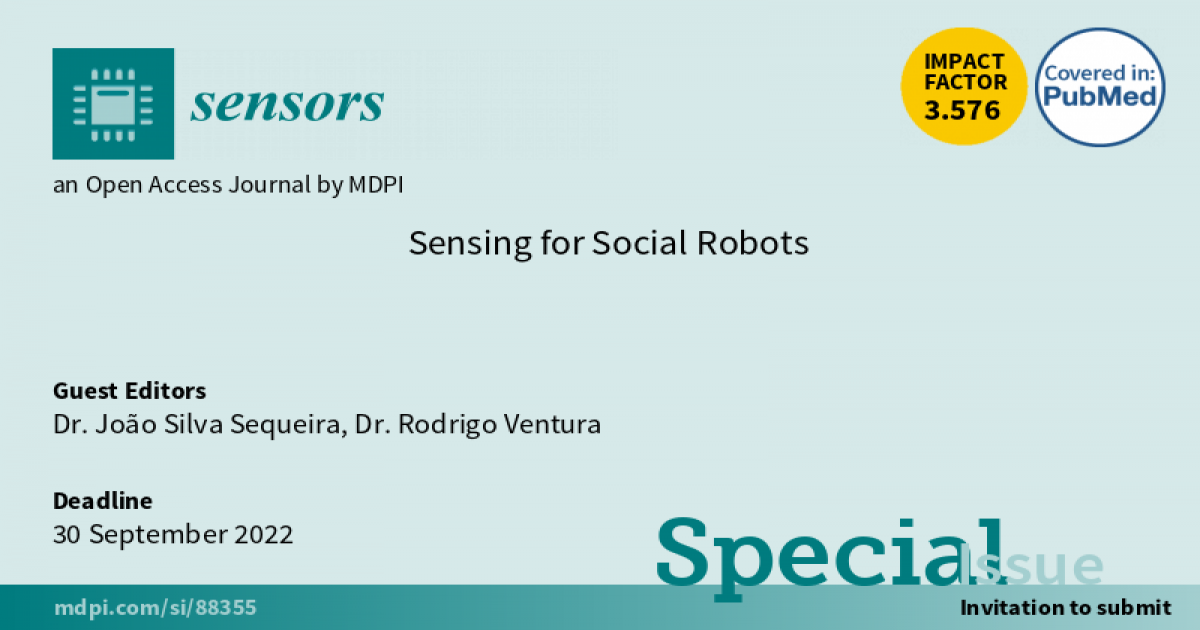Sensing for Social Robots
A special issue of Sensors (ISSN 1424-8220). This special issue belongs to the section "Sensors and Robotics".
Deadline for manuscript submissions: closed (30 September 2022) | Viewed by 14117

Special Issue Editors
Interests: social robotics; human–robot interaction; architectural aspects of robotics, including robot modeling and control; networked and cooperative robotics; system integration
Interests: space robotics; collaborative robots; human-robot interaction; mobile manipulation; machine learning
Special Issues, Collections and Topics in MDPI journals
Special Issue Information
Dear colleagues,
Social robots are getting ubiquitous, posing growing pressure on the robotics community to deliver these artificial entities able to play interesting roles in society. Robot skills are, slowly but surely, approaching humans’, i.e., to mimic and further extend humans’ typical skills. Hence, in addition to sensing matching human senses, there is a drive to develop novel sensors and processing techniques for the data produced.
The challenges for the sensors community are huge, ranging from materials to operation principles, mathematical models, sensor fusion, perception, and artificial intelligence, as well as hardware and software aspects. The need to estimate both concepts related to social sciences, e.g., emotions, and well-defined indicators, e.g., touch position and pressure, odors, and localization, is representative of the variety of sensor fields involved. In addition, networked social robotics extends the possibilities of sensor architectures. The dependability of robotics systems is affected by uncertainties typically present in social scenarios. Sensor uncertainties may even remain in the background of those intrinsic to social concepts, not affecting prospective robot skills. The importance of sensing in the context of social robots is thus clear.
This Special Issue aims at highlighting the current panorama and gathering novel ideas emerging in this exciting field.
Dr. João Silva Sequeira
Dr. Rodrigo Ventura
Guest Editors
Manuscript Submission Information
Manuscripts should be submitted online at www.mdpi.com by registering and logging in to this website. Once you are registered, click here to go to the submission form. Manuscripts can be submitted until the deadline. All submissions that pass pre-check are peer-reviewed. Accepted papers will be published continuously in the journal (as soon as accepted) and will be listed together on the special issue website. Research articles, review articles as well as short communications are invited. For planned papers, a title and short abstract (about 250 words) can be sent to the Editorial Office for assessment.
Submitted manuscripts should not have been published previously, nor be under consideration for publication elsewhere (except conference proceedings papers). All manuscripts are thoroughly refereed through a single-blind peer-review process. A guide for authors and other relevant information for submission of manuscripts is available on the Instructions for Authors page. Sensors is an international peer-reviewed open access semimonthly journal published by MDPI.
Please visit the Instructions for Authors page before submitting a manuscript. The Article Processing Charge (APC) for publication in this open access journal is 2600 CHF (Swiss Francs). Submitted papers should be well formatted and use good English. Authors may use MDPI's English editing service prior to publication or during author revisions.
Keywords
- social robots
- sensor uncertainties
- perception
- sensor fusion
- sensor modeling
- sensor networking
- human senses
- sensor dependability
Benefits of Publishing in a Special Issue
- Ease of navigation: Grouping papers by topic helps scholars navigate broad scope journals more efficiently.
- Greater discoverability: Special Issues support the reach and impact of scientific research. Articles in Special Issues are more discoverable and cited more frequently.
- Expansion of research network: Special Issues facilitate connections among authors, fostering scientific collaborations.
- External promotion: Articles in Special Issues are often promoted through the journal's social media, increasing their visibility.
- Reprint: MDPI Books provides the opportunity to republish successful Special Issues in book format, both online and in print.
Further information on MDPI's Special Issue policies can be found here.







